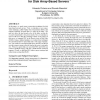Free Online Productivity Tools
i2Speak
i2Symbol
i2OCR
iTex2Img
iWeb2Print
iWeb2Shot
i2Type
iPdf2Split
iPdf2Merge
i2Bopomofo
i2Arabic
i2Style
i2Image
i2PDF
iLatex2Rtf
Sci2ools
ICS
2004
Tsinghua U.
2004
Tsinghua U.
Energy conservation techniques for disk array-based servers
In this paper, we study energy conservation techniques for disk array-based network servers. First, we introduce a new conservation technique, called Popular Data Concentration (PDC), that migrates frequently accessed data to a subset of the disks. The goal is to skew the load towards a few of the disks, so that others can be transitioned to low-power modes. Next, we introduce a user-level file server that takes advantage of PDC. In the context of this server, we compare PDC to the Massive Array of Idle Disks (MAID). Using a validated simulator, we evaluate these techniques for conventional and two-speed disks and a wide range of parameters. Our results for conventional disks show that PDC and MAID can only conserve energy when the load on the server is extremely low. When two-speed disks are used, both PDC and MAID can conserve significant energy with only a small fraction of delayed requests. Overall, we find that PDC achieves more consistent and robust energy savings than MAID. ...
Conservation Technique | Energy Conservation | ICS 2004 | Theoretical Computer Science | Two-speed Disks |
| Added | 01 Jul 2010 |
| Updated | 01 Jul 2010 |
| Type | Conference |
| Year | 2004 |
| Where | ICS |
| Authors | Eduardo Pinheiro, Ricardo Bianchini |
Comments (0)

